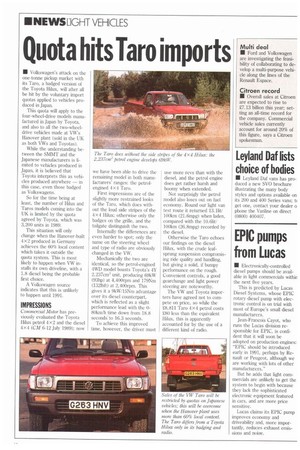Quota hits Taro imports
Page 16

If you've noticed an error in this article please click here to report it so we can fix it.
• Volkswagen's attack on the one-tonne pickup market with its Taro, a badged version of the Toyota Hilux, will after all be hit by the voluntary import quotas applied to vehicles produced in Japan.
This quota will apply to the four-wheel-drive models manufactured in Japan by Toyota, and also to all the two-wheeldrive vehicles made at VW's Hanover plant (sold in the UK as both VWs and Toyotas).
While the understanding between the SMMT and the Japanese manufacturers is limited to vehicles produced in Japan, it is believed that Toyota interprets this as vehicles produced anywhere — in this case, even those badged as Volkswagens.
So for the time being at least, the number of Hilux and Taros models coming into the UK is limited by the quota agreed by Toyota, which was 3,200 units in 1989.
This situation will only change when the Hanover-built 4 x 2 produced in Germany achieves the 60% local content which takes it outside the quota system. This is most likely to happen when VW installs its own driveline, with a 1.8 diesel being the probable first choice.
A Volkswagen source indicates that this is unlikely to happen until 1991.
IMPRESSIONS commercial Motor has previously evaluated the Toyota Hilux petrol 4 x2 and the diesel 4x4 (CM 6-12 July 1989); now we have been able to drive the remaining model in both manufacturers' ranges: the petrolengined 4x4 Taro.
First impressions are of the slightly more restrained looks of the Taro, which does without the loud side stripes of the 4 x4 Hilux; otherwise only the badges on the grille, and the tailgate distinguish the two.
Internally the differences are even harder to spot; only the name on the steering wheel and type of radio are obviously changed in the VW.
Mechanically the two are identical, so the petrol-engined 4WD model boasts Toyota's 4Y 2,237cm3 unit, producing 69kW (93hp) at 4,400rpm and 179Nm (1321bft) at 2,400rpm. This gives it a 9kWil5Nm advantage over its diesel counterpart, which is reflected as a slight performance lead with the 080kmdi time down from 18.8 second to 16.3 seconds.
To achieve this improved time, however, the driver must use more revs than with the diesel, and the petrol engine does get rather harsh and boomy when extended.
Not surprisigly the petrol model also loses out on fuel economy. Round our light van test route it returned 13.11iti 100km (21.6mpg) when laden, compared with the 10.61iti 100km (26.8mpg) recorded by the diesel.
Otherwise the Taro echoes our findings on the diesel Hilux, with the crude leafsprung suspension compromising ride quality and handling, but giving a solid, if bumpy performance on the rough. Convenient controls, a good gearchange and light power steering are noteworthy.
The VW and Toyota importers have agreed not to compete on price, so while the 28,811 Taro 4x4 petrol costs 280 less than the equivalent Hilux, this is apparently accounted for by the use of a different kind of radio.








































































































